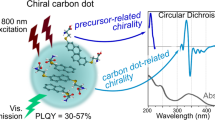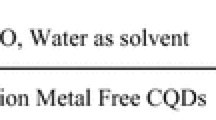Abstract
Chiral catalysis is one of the most direct and effective approach to obtain pure optical enantiomers. Chiral carbon dots (CDs) as carbon-based chiral catalysts show great potential in chiral catalysis. Herein, we report a facile one step base-catalyzed aldol condensation to fabricate the chiral CDs from glucose at ambient temperature and pressure. The formation of chiral CDs involves the processes of isomerization and aldol condensation. These chiral CDs have been demonstrated that they have selective capacity for electrocatalytic oxidization of tryptophan enantiomers. L type of CDs (LCDs) is more likely to catalyze L-tryptophan (Trp) than D-Trp with the selective factor (/L//D) of 1.60, whereas the D type of CDs (DCDs) tends to catalyze D-Trp (/L//D: 0.63). Theoretical calculations combined with various contrast experiments (temperature and pH) demonstrate that the selectively electrocatalytic capacity of chiral CDs toward Trp isomers is due to the different hydrogen-bond interactions between chiral CDs and Trp.

Similar content being viewed by others
References
Turek, M.; Biczak, R.; Pawlowska, B.; Różycka-Sokołowska, E.; Owsianik, K.; Marciniak, B.; Balczewski, P. The need to change the approach to the safe use of herbicides by developing chiral and environmentally friendly formulations: A series of enantioselective (R)- and (S)-phenylethylammonium chloroacetates. Green Chem. 2022, 24, 1693–1703.
Arenas, M.; Martín, J.; Luis Santos, J.; Aparicio, I.; Alonso, E. Enantioselective behavior of environmental chiral pollutants: A comprehensive review. Crit. Rev. Environ. Sci. Technol. 2022, 52, 2995–3034.
Zhang, H.; Lou, L. L.; Yu, K.; Liu, S. X. Advances in chiral metal-organic and covalent organic frameworks for asymmetric catalysis. Small 2021, 17, 2005686.
Huang, Y. H.; Hayashi, T. Chiral diene ligands in asymmetric catalysis. Chem. Rev. 2022, 122, 14346–14404.
Planas, O.; Cornella, J. Facile access to chiral non-natural amino acids. Nat. Catal. 2019, 2, 839–840.
Yuan, Y. C.; Mellah, M.; Schulz, E.; David, O. R. P. Making chiral salen complexes work with organocatalysts. Chem. Rev. 2022, 122, 8841–8883.
Rudroff, F.; Mihovilovic, M. D.; Gröger, H.; Snajdrova, R.; Iding, H.; Bornscheuer, U. T. Opportunities and challenges for combining chemo- and biocatalysis. Nat. Catal. 2018, 1, 12–22.
Döring, A.; Ushakova, E.; Rogach, A. L. Chiral carbon dots: Synthesis, optical properties, and emerging applications. Light: Sci. Appl. 2022, 11, 75.
Ru, Y.; Ai, L.; Jia, T. T.; Liu, X. J.; Lu, S. Y.; Tang, Z. Y.; Yang, B. Recent advances in chiral carbonized polymer dots: From synthesis and properties to applications. Nano Today 2020, 34, 100953.
Filippini, G.; Amato, F.; Rosso, C.; Ragazzon, G.; Vega-Peñaloza, A.; Companyó, X.; Dell’Amico, L.; Bonchio, M.; Prato, M. Mapping the surface groups of amine-rich carbon dots enables covalent catalysis in aqueous media. Chem 2020, 6, 3022–3037.
Liu, S.; He, Y.; Liu, Y.; Wang, S. B.; Jian, Y. J.; Li, B. X.; Xu, C. L. One-step hydrothermal synthesis of chiral carbon dots with high asymmetric catalytic activity for an enantioselective direct aldol reaction. Chem. Commun. 2021, 57, 3680–3683.
Ouyang, Y.; Biniuri, Y.; Fadeev, M.; Zhang, P.; Carmieli, R.; Vázquez-González, M.; Willner, I. Aptamer-modified Cu2+-functionalized C-dots: Versatile means to improve nanozyme activities—“Aptananozymes”. J. Am. Chem. Soc. 2021, 143, 11510–11519.
Zhang, M. L.; Zhang, W. R.; Fan, X.; Ma, Y. R.; Huang, H.; Wang, X. T.; Liu, Y.; Lin, H. P.; Li, Y. Y.; Tian, H. et al. Chiral carbon dots derived from serine with well-defined structure and enantioselective catalytic activity. Nano Lett. 2022, 22, 7203–7211.
Wang, M.; Li, C. H.; Zhou, M. L.; Xia, Z. N.; Huang, Y. K. Natural deep eutectic solvent assisted synthesis and applications of chiral carbon dots. Green Chem. 2022, 24, 6696–6706.
Di Noja, S.; Amato, F.; Zinna, F.; Di Bari, L.; Ragazzon, G.; Prato, M. Transfer of axial chirality to the nanoscale endows carbon nanodots with circularly polarized luminescence. Angew. Chem., Int. Ed. 2022, 61, e202202397.
Ru, Y.; Sui, L.; Song, H. Q.; Liu, X. J.; Tang, Z. Y.; Zang, S. Q.; Yang, B.; Lu, S. Y. Rational design of multicolor-emitting chiral carbonized polymer dots for full-color and white circularly polarized luminescence. Angew. Chem., Int. Ed. 2021, 60, 14091–14099.
Zhang, M. L.; Ma, Y. R.; Wang, H. B.; Wang, B.; Zhou, Y. J.; Liu, Y.; Shao, M. W.; Huang, H.; Lu, F.; Kang, Z. H. Chiral control of carbon dots via surface modification for tuning the enzymatic activity of glucose oxidase. ACS Appl. Mater. Interfaces 2021, 13, 5877–5886.
Zhang, M. L.; Wang, H. B.; Wang, B.; Ma, Y. R.; Huang, H.; Liu, Y.; Shao, M. W.; Yao, B. W.; Kang, Z. H. Maltase decorated by chiral carbon dots with inhibited enzyme activity for glucose level control. Small 2019, 15, 1901512.
Hou, H. S.; Banks, C. E.; Jing, M. J.; Zhang, Y.; Ji, X. B. Carbon quantum dots and their derivative 3D porous carbon frameworks for sodium-ion batteries with ultralong cycle life. Adv. Mater. 2015, 27, 7861–7866.
Li, L.; Li, Y. T.; Ye, Y.; Guo, R. T.; Wang, A. N.; Zou, G. Q.; Hou, H. S.; Ji, X. B. Kilogram-scale synthesis and functionalization of carbon dots for superior electrochemical potassium storage. ACS Nano 2021, 15, 6872–6885.
Li, J. L.; Smith, R. L. Jr.; Xu, S. Y.; Li, D.; Yang, J. R.; Zhang, K. Q.; Shen, F. Manganese oxide as an alternative to vanadium-based catalysts for effective conversion of glucose to formic acid in water. Green Chem. 2022, 24, 315–324.
Libnau, F. O.; Christy, A. A.; Kvalheim, O. M. Resolution of infrared spectra and kinetic analysis of mutarotation of D-glucose in water by sequential rank analysis. Vib. Spectrosc. 1994, 7, 139–148.
Bartolomei, B.; Bogo, A.; Amato, F.; Ragazzon, G.; Prato, M. Nuclear magnetic resonance reveals molecular species in carbon nanodot samples disclosing flaws. Angew. Chem., Int. Ed. 2022, 61, e202200038.
Chandra, S.; Karak, N. Environmentally friendly polyurethane dispersion derived from dimer acid and citric acid. ACS Sustainable Chem. Eng. 2018, 6, 16412–16423.
Sahoo, S.; Kalita, H.; Mohanty, S.; Nayak, S. K. Degradation study of biobased polyester-polyurethane and its nanocomposite under natural soil burial, UV radiation and hydrolytic-salt water circumstances. J. Polym. Environ. 2018, 26, 1528–1539.
Hardin, N. Z.; Kocman, V.; Di Mauro, G. M.; Ravula, T.; Ramamoorthy, A. Metal-chelated polymer nanodiscs for NMR studies. Angew. Chem., Int. Ed. 2019, 58, 17246–17250.
Das, A.; Kundelev, E. V.; Vedernikova, A. A.; Cherevkov, S. A.; Danilov, D. V.; Koroleva, A. V.; Zhizhin, E. V.; Tsypkin, A. N.; Litvin, A. P.; Baranov, A. V. et al. Revealing the nature of optical activity in carbon dots produced from different chiral precursor molecules. Light: Sci. Appl. 2022, 11, 92.
Li, F.; Li, Y. Y.; Yang, X.; Han, X. X.; Jiao, Y.; Wei, T. T.; Yang, D. Y.; Xu, H. P.; Nie, G. J. Highly fluorescent chiral N-S-doped carbon dots from cysteine: Affecting cellular energy metabolism. Angew. Chem., Int. Ed. 2018, 57, 2377–2382.
Suzuki, N.; Wang, Y. C.; Elvati, P.; Qu, Z. B.; Kim, K.; Jiang, S.; Baumeister, E.; Lee, J.; Yeom, B.; Bahng, J. H. et al. Chiral graphene quantum dots. ACS Nano 2016, 10, 1744–1755.
Vázquez-Nakagawa, M.; Rodríguez-Pérez, L.; Herranz, M. A.; Martín, N. Chirality transfer from graphene quantum dots. Chem. Commun. 2016, 52, 665–668.
Hu, R.; Zhai, X. C.; Ding, Y. B.; Shi, G. Y.; Zhang, M. Hybrid supraparticles of carbon dots/porphyrin for multifunctional tongue-mimic sensors. Chin. Chem. Lett. 2022, 33, 2715–2720.
Gao, P. L.; Xie, Z. G.; Zheng, M. Chiral carbon dots-based nanosensors for Sn(II) detection and lysine enantiomers recognition. Sens. Actuators B: Chem. 2020, 319, 128265.
Hu, L. L.; Li, H.; Liu, C. A.; Song, Y. X.; Zhang, M. L.; Huang, H.; Liu, Y.; Kang, Z. H. Chiral evolution of carbon dots and the tuning of laccase activity. Nanoscale 2018, 10, 2333–2340.
Souza, R. O. L.; Fabiano, D. P.; Feche, C.; Rataboul, F.; Cardoso, D.; Essayem, N. Glucose-fructose isomerisation promoted by basic hybrid catalysts. Catal. Today 2012, 195, 114–119.
Lima, S.; Dias, A. S.; Lin, Z.; Brandão, P.; Ferreira, P.; Pillinger, M.; Rocha, J.; Calvino-Casilda, V.; Valente, A. A. Isomerization of D-glucose to D-fructose over metallosilicate solid bases. Appl. Catal. A: Gen. 2008, 339, 21–27.
Zuo, B. J.; Wang, Q. L.; Wang, Y.; Ma, Y. D. Knoevenagel condensation over acidic zeolite. Chin. J. Catal. 2002, 23, 555–558.
Acknowledgements
This work is supported by Natural Science Foundation of Jiangsu Province (No. BE2022425), National Key R&D Program of China (Nos. 2020YFA0406104 and 2020YFA0406101), National MCF Energy R&D Program of China (No. 2018YFE0306105), the National Natural Science Foundation of China (Nos. 52271223, 52272043, 51725204, 51972216, 52202107, and 52201269), Innovative Research Group Project of the National Natural Science Foundation of China (No. 51821002), Key R&D program of Ningxia Hui Autonomous Region (No. 2022BEG02006), Ningxia Autonomous Region flexible introduction of science and technology innovation team (No. 2021RXTDLX08), Agricultural science and technology innovation project of Suzhou Science and Technology Development Plan (No. SNG2020074), Macau Youths Scholars Program, Collaborative Innovation Center of Suzhou Nano Science and Technology, the 111 Project, and Suzhou Key Laboratory of Functional Nano and Soft Materials.
Author information
Authors and Affiliations
Corresponding authors
Electronic Supplementary Material
12274_2023_5601_MOESM1_ESM.pdf
Chiral carbon dots from glucose by room temperature alkali-assisted synthesis for electrocatalytic oxidation of tryptophan enantiomers
Rights and permissions
About this article
Cite this article
Zhang, M., Fan, X., Du, X. et al. Chiral carbon dots from glucose by room temperature alkali-assisted synthesis for electrocatalytic oxidation of tryptophan enantiomers. Nano Res. 16, 8929–8936 (2023). https://doi.org/10.1007/s12274-023-5601-6
Received:
Revised:
Accepted:
Published:
Issue Date:
DOI: https://doi.org/10.1007/s12274-023-5601-6




